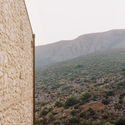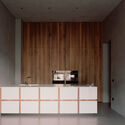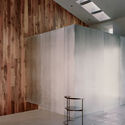
-
Architects: Andrea Eusebi
- Area: 160 m²
- Year: 2021
-
Photographs:Simone Bossi
-
Manufacturers: Agape, FLOS, Schüco

Text description provided by the architects. The project was meant to create a time gap, passing through the exterior and interiors, from the typical Abruzzo home at the bottom of the mountain to the inner space which is hardly recognizable from its original looks. The interior is a continuous play with shadows and lights, created with the new glass openings and the use of materials that intentionally want to create a strong sense of contrast.

The chosen planning approach uses a number of strategies: preservation/activation/demolition/integration. The final objective was of getting rid of the temporary stratification, replacing the incongruencies with solutions, without causing much contrast with the surrounding construction. The project has wanted to conserve and reactivate the existing volume of stone by making the existing wall structure evident again and by making it stand out via the use of contemporary technologies. The pitched roof has been demolished so as not to protrude by the façade anymore and by giving the impression of a mono-material monolith of short distance.


The existent stone volume has been treated by studying the natural light as effectively as possible, widening the existing openings. A sliding window with only a sash has been utilized in a totally unusual way, resulting in not having the division of two separate frames which would have limited the view of the valley and the way the sun rays enter the building.


A slab of metal at the lower ground frames one of the openings of equal dimensions and it represents a privileged point of view toward the beautiful landscape of the valley and of the garden. A distinctive element of the project is the inclusion of a vertical cut of glass starting from the bottom layer at the valley, passing through the stone wall, and hitting the ground as a nod to the previous division in two of the house. A fixed 11-meter-long glass creates an imaginary division of the building.


In the southern wall,16cm holes create a potent natural light source. The general idea was of having some internal spaces with contrasting areas of shadow and light. The ground floor contains two bedrooms and a living area, all full height, and also features a volume of metal that contains a bathroom. From this space, one can admire one of the two central walls, also at full height, which was layered in wood. From here, the view opens to the valley landscape and the terraced gardens.

On the floor below, there is a space with a large living and kitchen area, and a bedroom with another metal volume with a bathroom and suspended shower.



















